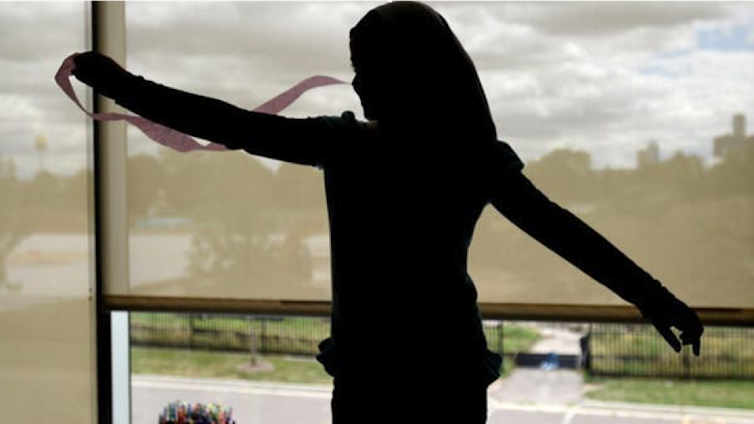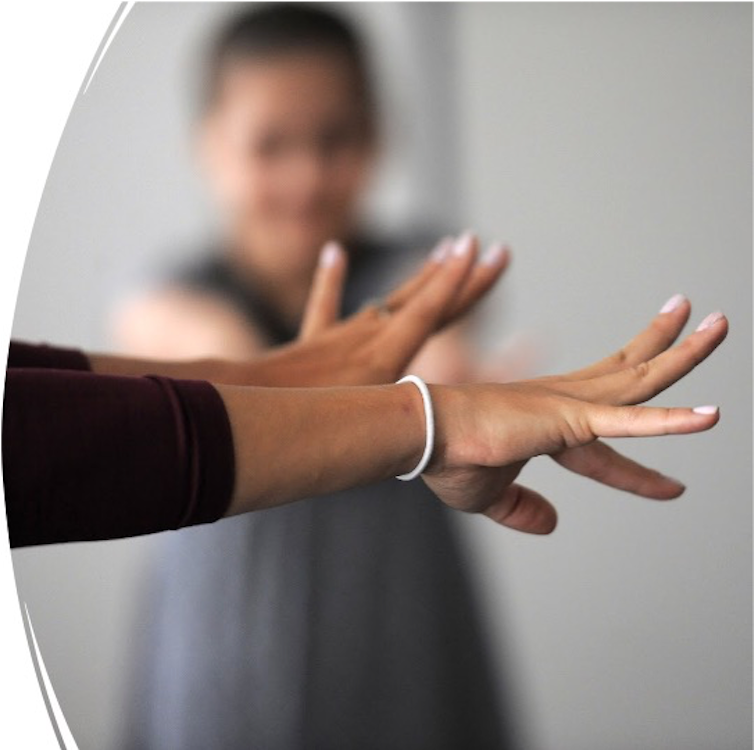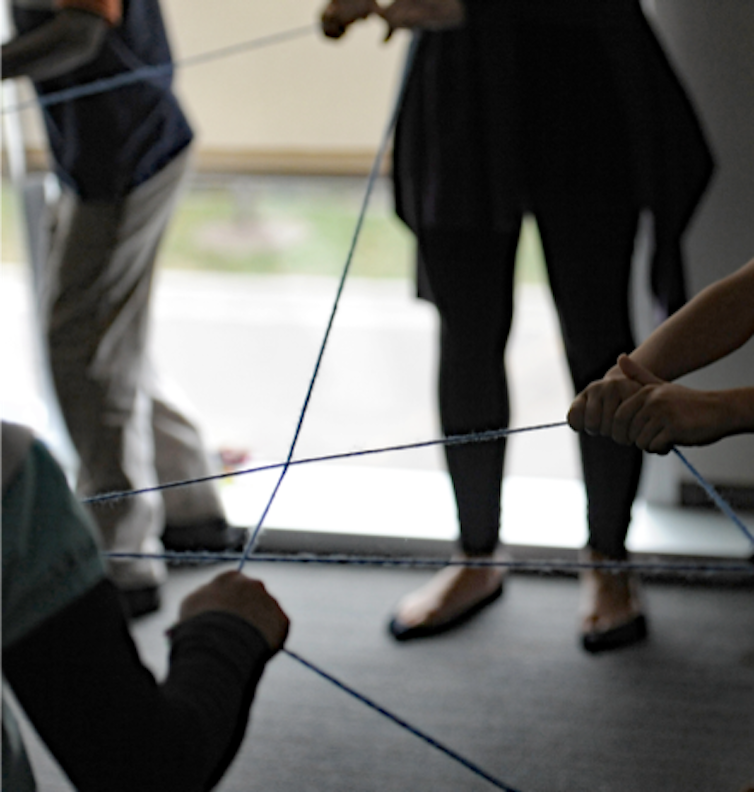Dance and movement therapy holds promise for treating anxiety and depression, as well as deeper psyc
The COVID-19 pandemic and a growing global refugee crisis have shone a light on the ever-increasing need for new approaches to mental health treatment.

A few years ago, framed by the skyline of Detroit, a group of about 15 children resettled as refugees from the Middle East and Africa leapt and twirled around, waving blue, pink and white streamers through the air.
The captivating scene was powerfully symbolic. Each streamer held a negative thought, feeling or memory that the children had written down on the streamers. On cue and in unison, the children released their streamers into the air, then sat down nearby. Then they gathered up the fallen streamers, which carried their collective struggles and hardships, threw them in a trash can and waved goodbye.
The children were participating in a dance therapy activity as part of our team’s research program exploring body-based approaches to mental health treatment in people resettled as refugees.
In 2017, our lab – the Stress, Trauma and Anxiety Research Clinic – began piloting movement therapies to help address trauma in refugee families. We are learning that movement may not only provide a way to express oneself, but also offer a path toward healing and lifelong strategies for managing stress.

On average, every year about 60,000 children are resettled as refugees in Western nations. Now, the refugee crisis resulting from the U.S. withdrawal from Afghanistan is bringing renewed attention to their needs. The UN Refugee Agency estimates that 6 million Afghans have been displaced over the past 40 years, and a new wave of tens of thousands are now fleeing from Taliban rule.
I am a neuroscientist who specializes in understanding how trauma reshapes the nervous system of developing youth. I use this information to explore creative arts and movement-based therapies to treat stress and anxiety. The instinct to move the body in expressive ways is as old as humanity. But movement-based strategies such as dance therapy have only recently been given much attention in mental health treatment circles.
As a dancer myself, I always found the nonverbal emotional expression offered through movement to be incredibly therapeutic – especially when I was experiencing significant anxiety and depression in high school and college. Now, through my neuroscience research, I am joining a growing number of scholars working to bolster the evidence base supporting movement-based interventions.
One mind and body
During the COVID-19 pandemic, the incidence of anxiety and depression doubled in youth. As a result, many people are searching for new ways to cope with and handle emotional turmoil.
On top of the pandemic, conflicts around the world, as well as climate change and natural disasters, have contributed to the growing global refugee crisis. This demands resources for resettlement, education and occupation, physical health and – importantly – mental health.
Interventions that offer physical activity and creativity components at a time when children and people of all ages are likely to be sedentary and with reduced environmental enrichment can be beneficial during the pandemic and beyond. Creative arts and movement-based interventions may be well-suited to address not just the emotional but also the physical aspects of mental illness, such as pain and fatigue. These factors often contribute to the significant distress and dysfunction that drive individuals to seek care.

Why dance and movement therapy?
Body movement in and of itself is known to have a multitude of benefits – including reducing perceived stress, lowering inflammation in the body and even promoting brain health. In fact, researchers understand that the majority of our daily communication is nonverbal, and traumatic memories are encoded, or stored, in nonverbal parts of the brain. We also know that stress and trauma live in the body. So it makes sense that, through guided practices, movement can be leveraged to tell stories, embody and release emotions and help people “move” forward.
Dance and movement therapy sessions place an emphasis on fostering creativity and adaptability in order to help people develop greater cognitive flexibility, self-regulation and self-direction. This is especially important because research shows that early-life experiences and how children learn to cope with them can have a lasting impact on their health into adulthood.
According to the Child Mind Institute Children’s Mental Health Report, 80% of children with anxiety disorders are not receiving the treatment they require. This might be due to barriers such as clinician availability and cultural literacy, cost and accessibility, and stigma surrounding mental health conditions and treatment.

We are finding that dance and movement therapy and other group behavioral health programs can help fill important gaps. For instance, these strategies can be used in combination with services people are already receiving. And they can provide an accessible and affordable option in school and community settings. Dance and movement therapy can also instill coping skills and relaxation techniques that, once learned, can last a lifetime.
But does it work?
Our research and that of others are showing that dance and movement therapy can build up children’s sense of self-worth, improve their ability to regulate their emotions and reactions and empower them to overcome obstacles.
Much like yoga and meditation, dance and movement therapy has, at the root of its practice, a focus on deep breathing through the diaphragm. This intentional breathing movement physically pushes on and activates the vagus nerve, which is a large nerve that coordinates a number of biological processes in the body. When I work with kids, I call this form of breathing and nerve activation their “superpower.” Whenever they need to calm down, they can take a deep breath, and by engaging their vagus nerve, they can bring their bodies to a more restful and less reactive state.
[Get the best of The Conversation, every weekend. Sign up for our weekly newsletter.]
An analysis of 23 clinical research studies indicated that dance and movement therapy may be an effective and appropriate method for child, adult and elderly patients experiencing a wide array of symptoms – including psychiatric patients and those with developmental disorders. And for both healthy individuals and patients, the authors concluded that dance and movement therapy was most effective for reducing the severity of anxiety compared with other symptoms. Research from our team has also shown promise for the benefits of dance and movement therapy in reducing symptoms of post-traumatic stress disorder and anxiety in youth who resettle as refugees.
We have scaled up these programs and brought them into the virtual classroom for six schools throughout the metro Detroit region during the pandemic.
Perhaps the most promising evidence for dance and movement therapy isn’t, as the saying goes, what the eyes cannot see. In this case, it is what the eyes can see: children releasing their streamers, their negative emotions and memories, waving goodbye to them and looking ahead to a new day.
Lana Ruvolo Grasser receives funding from the National Institute of Mental Health (F31MH120927). She is affiliated with the International Society for Traumatic Stress Studies, Anxiety and Depression Association of America, the National Science Policy Network and SciPol Detroit, the National Honor Society for Neuroscience--Nu Rho Psi--Wayne State Chapter, and Samaritas.
Read These Next
How the ‘slayer rule’ might play a role in determining who will inherit wealth from Rob Reiner and h
These rules have a long history in the United States. They played a role in the notorious murders by…
The celibate, dancing Shakers were once seen as a threat to society – 250 years later, they’re part
‘The Testament of Ann Lee,’ Mona Fastvold’s 2025 film, depicts part of the long history of Shaker…
As DOJ begins to release Epstein files, his many victims deserve more attention than the powerful me
Powerful men connected to Jeffrey Epstein are named, dissected and speculated about. The survivors,…






